Davies, Dennis William (Leading Aircraftman)
Killed in Action 1943-08-29


Birth Date: 1918
Born:
John Horatio Percy & Frances Maud Davies
Home: Minburn, Alberta (parents)
Enlistment:
Enlistment Date: Unknown
Service
RCAF
Unit
427 (B) Sqn- Squadron
Ferte Manus Certas Strike sure
Base
RAF Leeming
Rank
Leading Aircraftman
Position
Leading Aircraftman
Service Numbers
R/113216
Oxford DF471
Airspeed Oxford
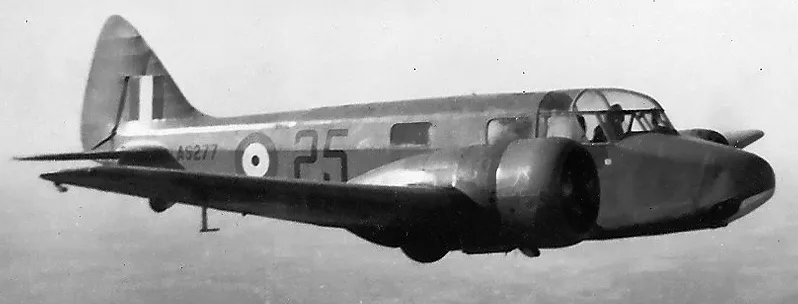
Airspeed A.S. 10 Oxford Mk. II, RCAF (Serial No. AS277), 25, in flight over Saskatchewan, 1942.
The Airspeed AS.10 Oxford was a twin-engine monoplane aircraft developed and manufactured by Airspeed. It saw widespread use for training British Commonwealth aircrews in navigation, radio-operating, bombing and gunnery roles throughout the Second World War.
The Oxford was developed by Airspeed during the 1930s in response to a requirement for a capable trainer aircraft that conformed with Specification T.23/36, which had been issued by the British Air Ministry. Its basic design is derived from the company's earlier AS.6 Envoy, a commercial passenger aircraft. Performing its maiden flight on 19 June 1937, it was quickly put into production as part of a rapid expansion of the Royal Air Force (RAF) in anticipation of a large-scale conflict.
As a consequence of the outbreak of war, many thousands of Oxfords were ordered by Britain and its allies, including Australia, Canada, France, New Zealand, Poland, and the United States. Following the end of the conflict, the Oxford continued to achieve export sales for some time, equipping the newly formed air forces of Egypt, India, Israel, and Yugoslavia. It was considered to be a capable trainer aircraft throughout the conflict, as well as being used a general-purpose type. A large number of Oxfords have been preserved on static display.Wikipedia
427 (B) Sqn Ferte Manus Certas ("Lion")
History of the Squadron during World War II (Aircraft: Wellington III, X, Halifax III, V, Lancaster I, III)
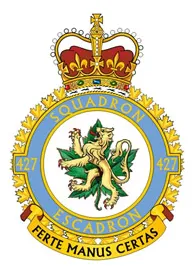
427 Squadron was the RCAF's 25th squadron and eighth bomber squadron to be formed overseas in WWII. It was formed at Croft, Yorkshire, England on 7 November 1942 as part of No 4 Group of RAF Bomber Command. With squadron code letters ZL it flew Wellington Mk III aircraft. On 1 January 1943 it joined No 6 (RCAF) Group, remaining at Croft until May of 1943, when it moved to Leeming, Yorkshire , where it remained for the rest of the war in Europe. Its duties were to take part in strategic and tactical bomber operations. It briefly re-equipped with Vickers Wellington Mk X before acquiring Handley Page Halifax Mk V aircraft in May 1943. In January 1944 it re-equipped again with the improved Halifax Mk III. Finally it was equipped with Avro Lancaster Mks I and III in March 1945. After the termination of hostilities in Europe, the squadron remained in England and transferred to No 1 Group. It participated in operation EXODUS, the repatriation of POW's and operation DODGE, bringing back British troops from Italy. The squadron disbanded at Leeming on 1 June 1946.
In the course of WWII the squadron flew approximately 3300 operational sorties in the course of which either 88 (Moyes) or 90 (Kostenuk) aircraft were lost and approximately 10,300 tons of bombs were dropped. The squadron earned 4 DSO's, 147 DFC'c and 6 Bars to DFC, 1 AFC, 2 CGM's, 16 DFM's and 8 MiD. Battle Honours were: English Channel and North Sea 1943-45, Baltic 1944-45, Fortress Europe 1943-44, France and Germany 1944-45, Biscay Ports 1943-44, Ruhr 1943-45, Berlin 1943-44, German Ports 1943-45, Normandy 1944, Rhine, Biscay 1944. Wikipedia, Moyes, Kostenuk and Griffin
Squadron History (Bomber Command Museum PDF)
Maps for Movements of 427 Squadron 1942-46
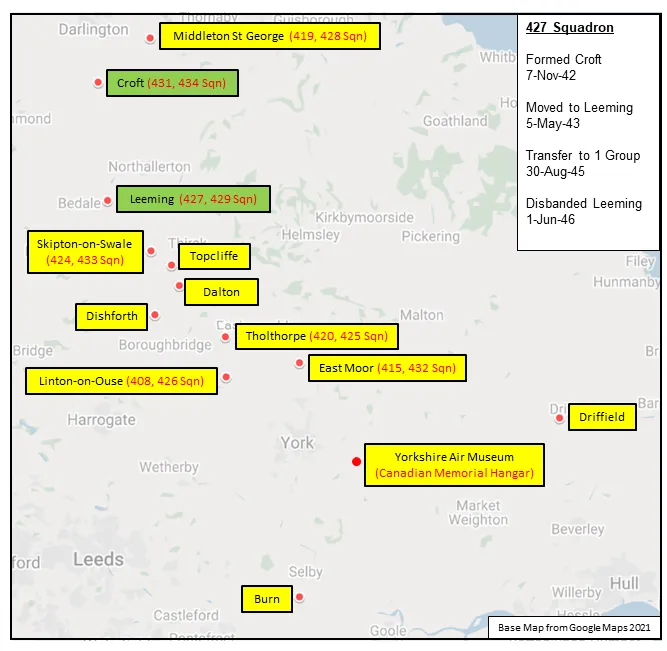
427 Squadron History Summary 1942-46
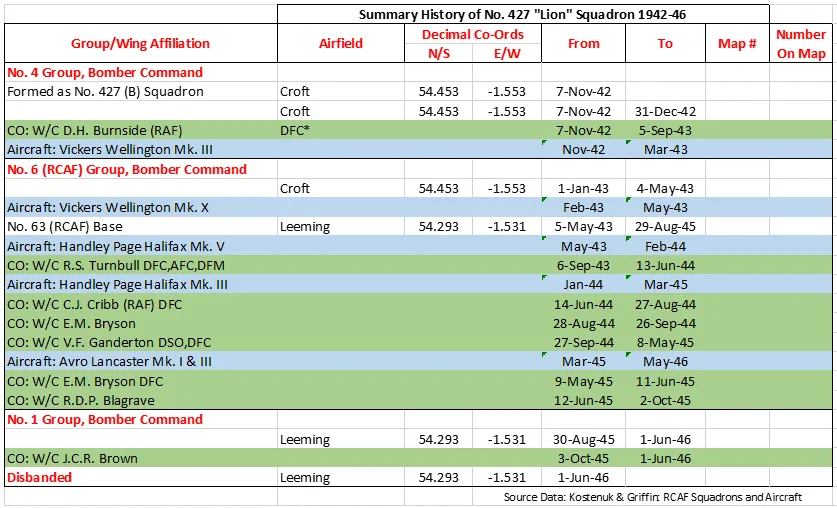
History of the Squadron Post-WWII (Aircraft: Sabre 2, 5, 6, Starfighter, Kiowa, Twin Huey, Griffon)
The squadron was reactivated on 1 August 1952 as a fighter squadron in the Air Defence Command, based in St Hubert, Quebec and equipped with Canadair F-86 Sabre Mk 2s. The Squadron moved on to Sabre Mks. 5 and 6 while working out of St Hubert before deploying to Zweibrücken, Germany and becoming a part of 3 Wing, in March-April 1953. The Squadron continued in this role, operating out of Germany, for another decade, participating in many multi-national NATO exchanges and exercises with destinations including; Rabat, Morocco, Decimomannu, Sardinia and France. The squadron moved to Grostenquin, France in June 1962, but was inactive pending its conversion to the CF-104 Starfighter. On 15 December 1962, the Squadron was deactivated as a Fighter squadron and reactivated on the 17th as a Strike/Attack squadron, becoming the first Canadian squadron to be equipped with the Starfighter. This change in aircraft necessitated changes in training and tactics. In 1969 the squadron moved from Zweibrücken to Baden-Soellingen , and with that, a change from 3 Wing to 4 Wing.
The Squadron disbanded again on 1 July 1970 and was re-established on 1 January 1971 as a Tactical Helicopter Squadron with 10 Tactical Air Group of Mobile Command, later simply called ‘Air Command.’ The first helicopter used after this transition was the CH-136 Kiowa light observer helicopter and, simultaneously, the CH-135 Twin Huey utility helicopters. The Squadron participated in many operations, including: Norway, Egypt, Sinai and Central America. After switching to a fleet of only CH-135 Twin Hueys in 1992, the squadron deployed to Somalia in 1993 and to Haiti on Operations. In July 1997 the Squadron received the BELL CH-146 Griffon Helicopter fleet to replace the Twin Huey. By 1999, the Griffon’s had participated in operations in Canada and in Honduras. The early 2000’s saw rotations going to Bosnia.
On 1 February 2006, 427 Squadron became part of Canadian Special Operations Forces Command (CANSOFCOM), as a Special Operations Aviation Squadron (SOAS), with the responsibility of providing air capability to various units with the Canadian Special Forces Command, where it remains today, located at Canadian Forces Base Petawawa, Ontario . In recent years, 427 SOAS participated in Exercise FLINTLOCK, an annual regional exercise among African, Western and United States counterterrorism forces, in multiple countries in West Africa. It also deployed to the Middle-East as part of Operation IMPACT, the Canadian Armed Forces mission to build the military capabilities of Iraq, Jordan and Lebanon, and set the conditions for their long-term success. 
 Minburn, Alberta (parents)
Minburn, Alberta (parents) Canadian Virtual War Memorial
Canadian Virtual War Memorial
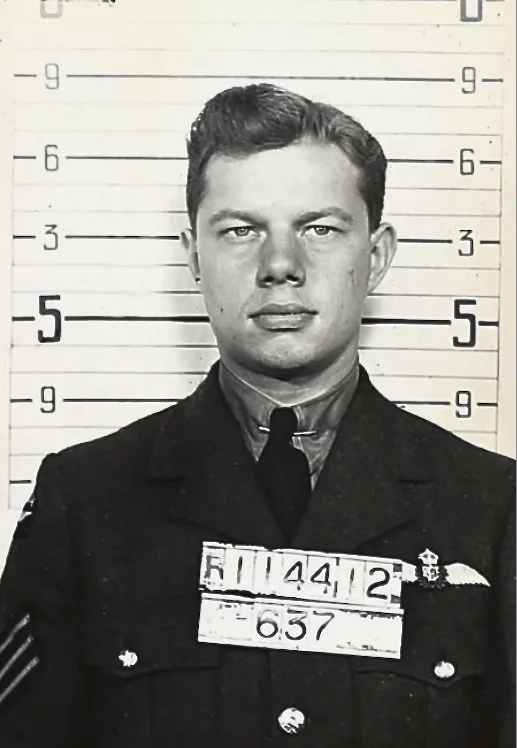
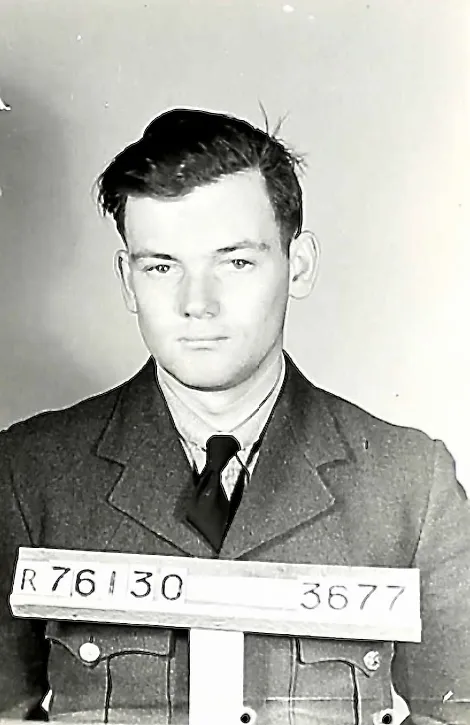
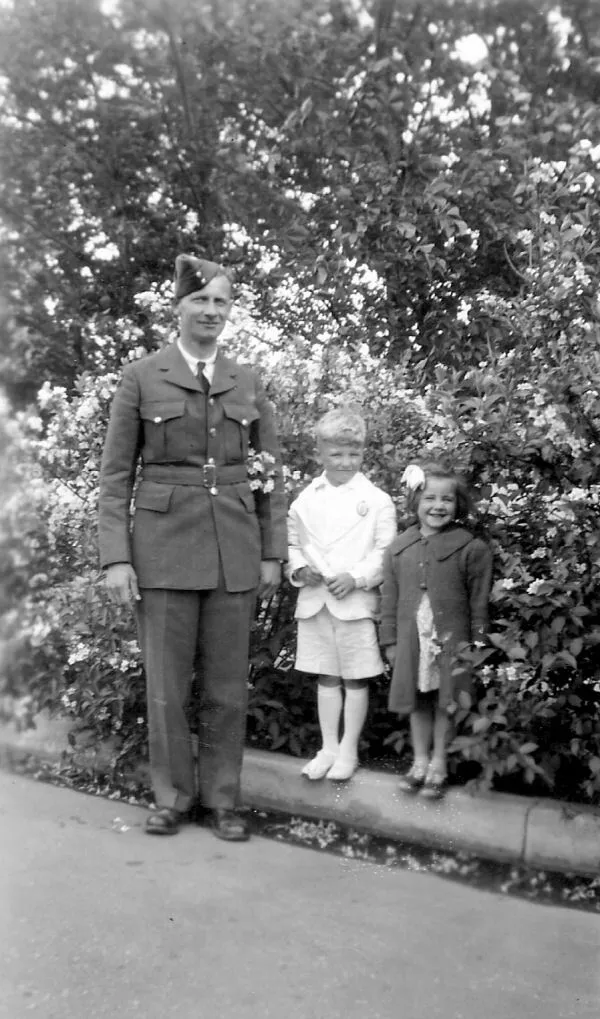
 Oxford Trainer
Oxford Trainer Wikipedia Oxford Trainer
Wikipedia Oxford Trainer Harold A Skaarup Web Page
Harold A Skaarup Web Page